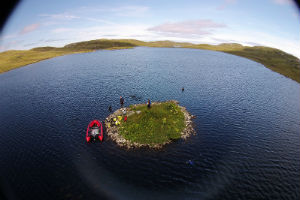Neolithic people built Scottish artificial islands
14 June 2019

Archaeologists have made the astounding discovery that some of the Scottish crannogs - artificial islands constructed in lakes and sea inlets - date to the Neolithic period.
This is far earlier than previously assumed, as the general consensus had been until now that they were built, used, and re-used over a period of 2,500 years from the Iron Age to the postmedieval period. Four crannog sites in the Outer Hebrides have now been conclusively radiocarbon dated to c.3640–3360 BC, shifting the timeline by thousands of years.
In 2012, Chris Murray, a resident of Lewis and former Royal Navy diver, decided to explore the loch bed around one such islet, and in doing so he made a remarkable discovery. Scattered around the islet were a series of extraordinarily well-preserved Early/Middle Neolithic pots lying on the loch bed. Following this discovery, Murray and Mark Elliot, the then-conservation officer at Museum nan Eilean in Stornoway, found similar assemblages at five more crannog sites across Lewis.
Garrow and Sturt, publishing in Antiquity, present the results of their collaboration with Murray in 2016/17, which aimed to confirm what this pottery suggested - that these crannogs could date to the Neolithic period.
Using a combination of ground and underwater survey, photogrammetry, palaeoenvironmental coring and excavation, the project obtained conclusive evidence of artificial islet construction in the Outer Hebrides during the Neolithic period. These crannogs therefore represent a monumental effort thousands of years ago, through the piling up of boulders on the loch bed, and in the case of Loch Bhorgastail, the building of a stone causeway.
Substantial quantities of Neolithic ceramic vessels were recovered from the lochs, and the large fragmental sizes suggest that at least some, and possibly all, of the vessels were complete when they entered the water. This means there was a systematic and possibly ritualised deposition from the islets. The sites on Lewis were certainly monumental, in terms of the work it took to construct them and their location, with their watery surroundings creating separation from everyday life.
These Neolithic crannogs remind us to ‘question the binary opposition sometimes assumed between Neolithic settlements and monuments (e.g. passage graves), and there may be many more. Although the Outer Hebrides have a significant number of crannogs, they are also common across the rest of Scotland and Ireland.
Only 10% of these have been radiocarbon dated, and only 20% in total have been dated at all. The research team believe it is possible that more Neolithic crannogs exist, but cannot be certain until further investigations are conducted. They represent a new type of site for the British Neolithic, with new deposition practices, and the possibilities for future work.
